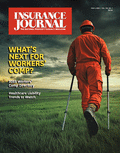Lessons in loss prevention help keep commercial property insurance clients from becoming statistics
You may be familiar with the word “mulligan.” In golf it means a chance to do it over without a penalty. Unfortunately, in the world of loss prevention and property protection, a mulligan is typically not an option. In fact, 75 percent of all companies that suffer a severe property loss never make it back to their pre-loss level of business. While this is a staggering and frightening statistic, it should serve as an incentive to ensure that your clients have in place an adequate level of protection for their exposures. To help protect businesses from becoming statistics, focus their prevention efforts on eliminating or minimizing exposures from the main loss causes: fire, explosion, water, hail, wind and snow.
Fire
According to a recent analysis of losses by a major property insurance company, fire is the leading loss driver for commercial property, accounting for 43 percent of all property losses by number and 53 percent of all property loss dollars. The study findings show that the top four causes of fire are electrical (21 percent), incendiary (16 percent), cooking (8 percent), and hot work (7 percent).
Automatic sprinkler protection has been proven to be the single greatest tool in protecting life and property from the ravages of fire. It is well worth the cost to provide the appropriate automatic sprinkler protection throughout all areas of combustible construction and occupancy. Although, it is important to note, that not all sprinkler systems are the same. Sprinkler system requirements for an office building differ vastly from those for a manufacturing or warehousing operation. Therefore, it is critical to work with an insurance company’s loss prevention department to help ensure the system provides an adequate level of protection for exposures.
As the cause of nearly a quarter of all commercial property fires, it is important to minimize exposure to electrical hazards. One way is through the implementation of an electrical preventative maintenance program. Part of this program should include an infra-red imaging scan of all electrical boxes, transformers and key electrical components, which can identify, and correct, potential electrical hazards.
Explosions/combustible liquids
One of the most prevalent special hazards in the workplace is flammable/combustible liquids. Once ignited, it is often difficult, if not impossible, to control or extinguish this type of fire. To ensure protection against this severe exposure, it is imperative to implement adequate safeguards.
Unfortunately, most people do not fully understand the nature or severity of the risk posed by flammable/combustible liquids. Combustible liquids, such as hydraulic fluid, play a vital role in the day-to-day operations that are typically thought of as intrinsically safe such as metal working, office buildings and plastic injection molding operations. In metal working, hydraulic fluid is often used to power presses, slitters and other metal working equipment; in an office building it can be used to operate the elevator; and in a plastic injection molding operation hydraulic fluid is used to make the press operate. In each instance, the combustible liquid is used under pressure, which is where the greatest exposure exists.
Properly designed automatic fire sprinkler system in buildings or areas where hydraulic fluids are used under pressure can be used to protect against this type of occurrence. This hydraulic system should have appropriate interlocks that shut down the equipment in the event of a fire to minimize the amount of hydraulic fluid available to fuel the fire. To do this, position smoke/heat detectors above each piece of equipment and wire them directly into the equipment’s emergency stop system to de-energize the pumps and stop the flow of hydraulic fluid. You can also arrange hydraulic pumps to immediately shut down upon activation of the automatic sprinkler system. Additionally, install manual emergency shut-off devices so that employees can readily shut the equipment down in the event of an emergency.
Establish a routine inspection procedure for all equipment, hoses, and fittings for signs of wear or fatigue. Lastly, training and pre-emergency planning is critical to ensure that employees are aware of the potential hazards that exist and that they understand their role in maintaining a safe working environment.
Water damage
Each year water damage claims cost business owners millions of dollars and there is a wide variety of causes for these claims: accidental mechanical damage, frozen pipes, acts of malicious mischief or vandalism, or broken sprinkler system piping. To help reduce the damage caused by unexpected water discharge, regularly inspect all plumbing valves, connections and equipment to ensure they are in good condition and free of leaks or corrosion. Also, putting all sprinkler control valves through their full range of motion in an annual test helps keep them turning freely and in prime working condition.
However, even with a solid preventative maintenance program, there will be times when water unexpectedly streams through a building. To help minimize loss, make sure — in advance of a situation — that water control valves are accessible and that management, maintenance and security personnel know valve location and operation procedures. Provide written emergency procedures including notification instructions and the contact information for the contractor, water and fire departments to key personnel. Another good preventive measure is to work with the local fire department to coordinate procedures for promptly shutting sprinklers off in non-fire situations.
In operations such as hotels, motels and dormitories, post appropriate signage warning against tampering with sprinkler heads and, especially, post stickers that discourage patrons from hanging clothing on sprinkler heads.
Weather-related losses
Weather-related emergencies range from relatively small, isolated storms to major catastrophic incidents such as Hurricane Katrina where serious damage to buildings and structures may result from hail, wind, and/or snow. Adequately preparing to survive weather-related loss often begins with the building layout and construction. One way is to incorporate proper roof designs, flood zone considerations, window and door protections into buildings located in areas prone to natural catastrophe and weather related conditions typical of the area.
Install hail-resistant roofing materials, such as stone ballast, and protect roof membranes with materials and components listed and/or approved by a nationally recognized testing laboratory for their intended purpose in hail-prone areas. To pre-plan for possible hail storm damage, have on hand emergency roof patching materials, waterproof tarps, etc. and, if possible, have prior arrangements with roofing contractors for immediate post-storm service. Also store susceptible materials and contents off the floor using pallets or shelves to minimize water damage.
Ensure that all roof flashing, roof decks and other roof edge treatments are in good condition and securely fastened. Verify that the roof deck is fastened to the structural frame and all roof coverings are fastened to the roof deck — especially in the corners and edges. In times of high wind, these loose edge treatments can lift and fail, which can contribute to roof damage and possible failure of the roofing system.
Snow accumulation puts an additional dead load on the roof that can quickly lead to either a partial, or total, collapse of the structure. Because of this, owners should develop a snow removal plan for not only parking lots and sidewalks, but also for the roof. For snow-prone areas, inspect the roof’s structural members to ensure they have adequate diagonal bracing. This is especially important when dealing with buildings equipped with standing seam roofs. As snow accumulates on the roof of a structure, lateral forces are exerted that can lead to structural member failure. Inadequate diagonal bracing increases the chances of structural member failure and roof collapse.
During inspection, verify that the roof structure is strong enough to withhold accumulated snow in areas susceptible to drifting such as where there is a change in roof height. The area of greatest concern is where there is significant elevation change in the roof level. Keep roof drains open and free of obstructing materials such as debris, waste materials, or the roof covering itself that can get in the way after being replaced. Snow must be able to drain from the roof as it melts.
Every day commercial businesses face conditions and situations that can expose them to property loss. By utilizing available resources such as the guidance and direction of a loss prevention engineer, businesses will be in a better position to minimize damage and potential downtime when a loss does occur. Be part of the solution and protect investments through aggressive loss prevention efforts.
Ralph Tiede is the vice president of Loss Prevention for Liberty Mutual Property.
Topics Profit Loss Commercial Lines Business Insurance Property
Was this article valuable?
Here are more articles you may enjoy.


 Staff Cuts Help Fuel GEICO Profit; Auto Insurer Not ‘Pouring Money’ Into AI
Staff Cuts Help Fuel GEICO Profit; Auto Insurer Not ‘Pouring Money’ Into AI  Florida Citizens ‘Going Naked’ on Reinsurance Below Cat Fund Layer
Florida Citizens ‘Going Naked’ on Reinsurance Below Cat Fund Layer  New York High Court Unleashes Expanded Liability for Pet Owners
New York High Court Unleashes Expanded Liability for Pet Owners  Why Trump Is Ending Enforcement of Civil Rights Laws That Ban ‘Disparate Impact’
Why Trump Is Ending Enforcement of Civil Rights Laws That Ban ‘Disparate Impact’ 


